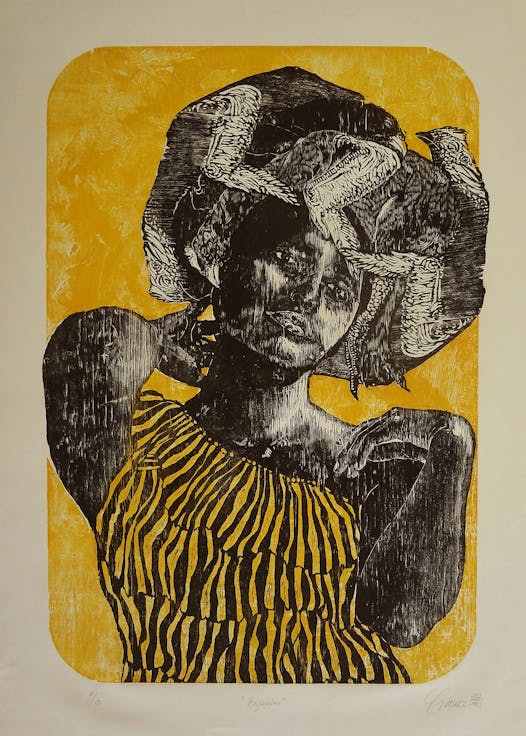At a time when building a wall to keep out Mexicans is a hot topic north of the border, it's refreshing to see what Mexicans themselves are thinking about.
Walls are not on their minds, nor in evidence in "Sus Voces: Women Printmakers From Mexico," a handsome and thematically rich show of woodcuts, lithographs, etchings and other original prints by nine contemporary Mexican artists.
Political undercurrents do ripple through the women's work, but they're never partisan, nationalistic or even very obvious. This is not poster art or propaganda. Instead, the 45 images refract contemporary Mexican culture through observations of urban life, personal experiences and such familiar emotions as love, longing and melancholy. Nuanced and complex, they are a quiet rebuke to the bombastic caricatures of Mexico that are so rife in parts of the United States.
In fact, misleading stereotypes saturate both cultures.
"When I visit my family in Mexico City, they ask how I can live here in the U.S. because it's so violent," said Maria Cristina Tavera, the show's bilingual/bicultural curator, who grew up in Minnesota and holds dual citizenship in the two countries. "They wonder how I dare send my children to school because of all the school-related shootings here."
As in the United States, parts of Mexico are afflicted with random or drug-fueled violence, she said, and people react much the same way.
"You are aware of it and the implications of what could happen, so you protect yourself to survive just as we do here," Tavera said.
Beyond politics
Only Mercedes López Calvo addresses the topic head-on in woodcuts that could have been inspired by news photos. One depicts a circle of men lying face down on the ground, hands clasped behind their necks, as if awaiting arrest or execution. The other shows three bound bodies with shirts pulled over their heads. But the same artist turns to more pacific subjects in a suite of keenly observed leaves, mottled, tangled and curled together.
Three powerful woodcuts by Diana Morales Galicia more subtly evoke claustrophobia and fear by focusing on feral dogs lurking in tangled grass, a couple trapped in a basket-like cage and a dog sniffing a bound and blindfolded man. In nearly abstract images of rickety scaffolding and a cyclone of birds rising from a decaying roller coaster, she hints at urban problems in Mexico City, the Western Hemisphere's largest metropolitan area with a population of 21.2 million.
With lithographs of furry boats and insect-headed creatures, Daniela Ramirez taps into a long-running strain of Mexican surrealism, as does Adriana Calatayud Morán in her poetic fusion of animal torsos with human heads and innards.
Young love and saucy fashions find expression in the lighthearted prints of Jimena Ramos, while Rossana Cervantes Vasquez uses snakes and moonlight to suggest psychological mysteries, and Paulina Olascoaga Chávez invests dying flowers with heavy symbolism.
Poignant self-portraits
The show's most arresting images are dramatic self-portraits by two artists.
In two linocuts, each more than 3 feet tall, the face of América Rodriguez seems to rise from dark pools through which flicker tiny fish and tendrils of seaweed. In her third portrait, Rodriguez presents herself as a Madonna-like figure framed by a lacy white mantilla. Only a lizard scrambling across her forehead shatters the sanctity of the scene.
In her moody and introspective woodcuts, Edith Chávez appears adrift in reverie — asleep, dreaming or mesmerized by her image in a mirror. At more than 3 feet tall, all five images are expertly printed from wooden panels whose visible grain imprints the images with soft streaks akin to rain or tears.
The watery effect enhances the intimate strangeness of the women and their chickens. Yep, chickens. Each is wrapped in or holding parts of the birds. One tenderly lifts a necklace of chicken feet; another holds a bird head in each hand; a third reaches up to adjust a turban made of plucked chickens wrapped tightly about her head, and so on. Obviously there are symbolic associations to be made between these melancholy women and the naked birds, but interpreting these haunting images as morality tales, religious parables or sociopolitical cartoons would trivialize them. They're way too memorable for that.
Mary.abbe@startribune.com
612-673-4431
Twitter: @maryabbe

An infamous heist put this North Woods town in the global spotlight. Nervous breakdowns and Hollywood deals ensued.

Caitlin Clark helps KARE 11 and Fox 9 reporters bond with their daughters

Fewer loon chicks surviving due to climate change, researchers say



